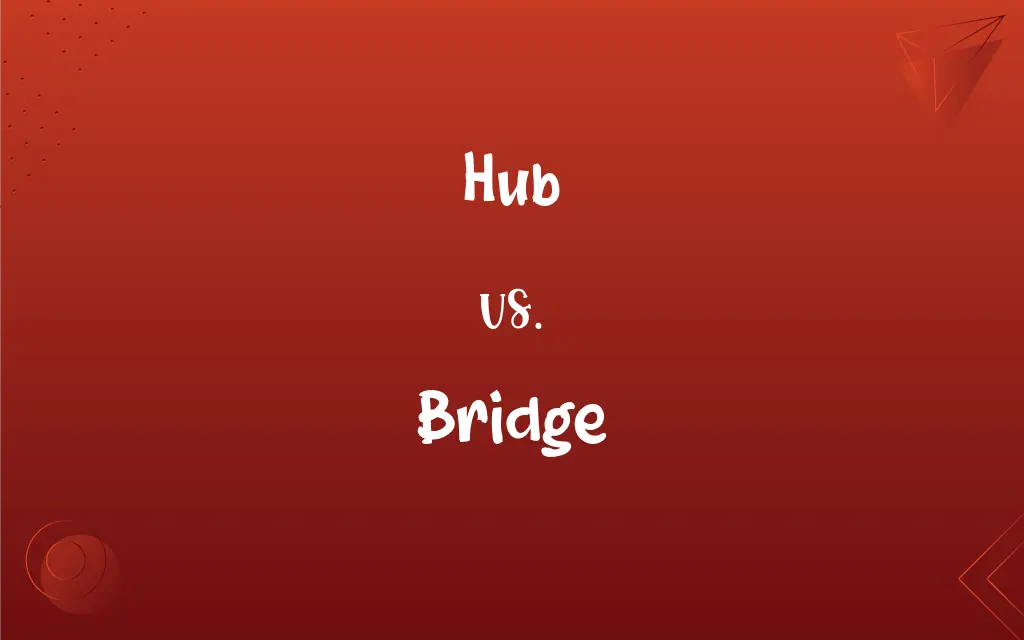Hub vs. Bridge: What's the Difference?
Edited by Aimie Carlson || By Janet White || Published on February 10, 2024
A hub is a network device that connects multiple Ethernet devices together, operating at the physical layer, while a bridge connects different network segments, operating at the data link layer.

Key Differences
A hub is a basic networking device that connects multiple Ethernet devices, operating at the physical layer of the OSI model. A bridge, on the other hand, connects two or more network segments, operating at the data link layer.
Hubs transmit data to all connected devices, leading to possible data collisions. Bridges intelligently manage data flow and reduce collisions by learning the MAC addresses of connected devices.
A hub’s indiscriminate data broadcasting can lead to network inefficiencies. Bridges enhance network performance by filtering and forwarding data based on MAC addresses.
Hubs are used within a single network segment. Bridges, however, can connect and extend two different network segments, even if they use different protocols.
Hubs are simpler and more suited for small, basic networks. Bridges are more complex and used in larger networks to divide network segments and reduce traffic.
ADVERTISEMENT
Comparison Chart
Operating Layer
Physical layer of OSI model
Data link layer of OSI model
Data Transmission
Broadcasts data to all ports
Selectively forwards data based on MAC addresses
Network Efficiency
Less efficient due to data collisions
More efficient, reduces collisions
Network Type
Connects devices within a single segment
Connects and extends different segments
Complexity
Simple, plug-and-play device
More complex, with traffic management
ADVERTISEMENT
Hub and Bridge Definitions
Hub
Physical Layer Tool.
Hubs operate at the physical layer of the OSI model.
Bridge
Intelligent Data Filter.
A bridge filters and forwards data based on MAC addresses.
Hub
Network Connecting Device.
The hub connects all office computers in a single network.
Bridge
Network Segment Connector.
The bridge connects two separate segments of our corporate network.
Hub
Simple Networking Device.
A hub is a basic and straightforward networking device for small setups.
Bridge
Data Link Layer Device.
Bridges operate at the data link layer, managing data flow.
Hub
Multiple Port Device.
This hub has eight ports to connect various Ethernet devices.
Bridge
Traffic Management Tool.
The bridge reduces network traffic through intelligent data forwarding.
Hub
Data Broadcast Point.
A hub broadcasts messages to every connected device.
Bridge
Network Extender.
Using a bridge can extend the range and capabilities of our network.
Bridge
(computing) A device which connects two or more computer buses, typically in a transparent manner.
This chip is the bridge between the front-side bus and the I/O bus.
Bridge
(programming) A software component connecting two or more separate systems.
Bridge
(networking) A system which connects two or more local area networks at layer 2 of OSI model.
The LAN bridge uses a spanning tree algorithm.
FAQs
Do bridges learn device addresses?
Yes, bridges learn the MAC addresses of connected devices for efficient data forwarding.
What does a bridge do in a network?
A bridge connects and manages traffic between different network segments.
Are hubs intelligent devices?
Hubs are not intelligent; they broadcast data to all connected devices.
What is a hub in networking?
A hub is a device that connects multiple Ethernet devices in a network.
Can a hub reduce network traffic?
No, a hub can increase traffic due to its broadcasting nature.
What layer does a bridge operate on?
A bridge operates at the data link layer of the OSI model.
Are hubs easy to set up?
Yes, hubs are plug-and-play devices and easy to set up.
How does a bridge improve network performance?
A bridge improves performance by reducing collisions and managing traffic.
Can a hub connect different network types?
No, a hub connects devices within the same network type.
Can a bridge filter data?
Yes, bridges filter data based on MAC address information.
Can a bridge extend a network's range?
Yes, bridges can extend the range by connecting different segments.
Are bridges compatible with wireless networks?
Bridges can be used in both wired and wireless network setups.
Is a hub cheaper than a bridge?
Hubs are generally cheaper due to their simpler functionality.
Can a bridge connect more than two segments?
Some advanced bridges can connect multiple network segments.
Is a hub suitable for large networks?
Hubs are less suitable for large networks due to inefficiency.
Do hubs require configuration?
Hubs typically do not require configuration.
Do hubs have IP address learning capability?
No, hubs do not have IP address learning capabilities.
Do bridges work with different protocols?
Bridges can connect segments with different protocols.
How do bridges handle data collisions?
Bridges reduce data collisions through intelligent forwarding.
What is the primary use of a hub?
The primary use of a hub is to connect multiple network devices.
About Author
Written by
Janet WhiteJanet White has been an esteemed writer and blogger for Difference Wiki. Holding a Master's degree in Science and Medical Journalism from the prestigious Boston University, she has consistently demonstrated her expertise and passion for her field. When she's not immersed in her work, Janet relishes her time exercising, delving into a good book, and cherishing moments with friends and family.
Edited by
Aimie CarlsonAimie Carlson, holding a master's degree in English literature, is a fervent English language enthusiast. She lends her writing talents to Difference Wiki, a prominent website that specializes in comparisons, offering readers insightful analyses that both captivate and inform.































































